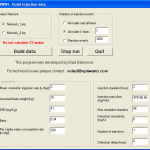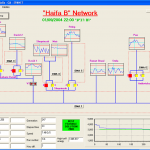Elad is an active member in international and and local (Israeli) research projects. The outcome of some of these project are reflected in the publication section.To name a few:
Fiware4Water – member of the project’s advisory board
FIWARE is a smart solution platform, funded by the EC (2011-16) as a major flagship PPP, to support SMEs and developers in creating the next generation of internet services, as the main ecosystem for Smart City initiatives for cross-domain data exchange/cooperation and for the NGI initiative. So far little progress has been made on developing specific water-related applications using FIWARE, due to fragmentation of the water sector, restrained by licensed platforms and lagging behind other sectors (e.g. telecommunications) regarding interoperability, standardisation, cross-domain cooperation and data exchange. Fiware4Water intends to link the water sector to FIWARE by demonstrating its capabilities and the potential of its interoperable and standardised interfaces for both water sector end-users (cities, water utilities, water authorities, citizens and consumers), and solution providers (private utilities, SMEs, developers). (Fiware4Water)
STOP-IT
The H2020 project “Strategic, Tactical, Operational Protection of water Infrastructure against cyber-physical Threats” (STOP-IT) focuses on the protection of critical water infrastructures (CIs) against physical and cyber threats. STOP-IT brings together a team of major water utilities, industrial technology developers, high tech SMEs and top European Research and Development (R&D) providers. STOP-IT solutions include:
a) mature technologies improved via their combination and embedment (including public warning systems, smart locks)
b) novel technologies (including fault-tolerant control strategies for SCADA integrated sensors, high-volume real-time sensor data protection via blockchain schemes; irregular human detection using new computer vision methods and WiFi and efficient water contamination detection algorithms)
The solutions are demonstrated with a front-runner/follower approach, where four advanced front-runner utilities, Aigües de Barcelona (Spain), Berliner Wasserbetriebe (Germany), Mekorot (Israel) and Oslo VAV (Norway) are twinned with Hessenwasser (Germany), Bergen Kommune (Norway), Emasagra (Spain) and DeWatergroep (Belgium), to stimulate mutual learning, transfer and uptake. (STOP-IT)
W3-Hydro
Water Quality Event Detection for Urban Water Security and Urban Water Management Based on Hydro-toxicological Investigations.
Battle of the Water Networks II
The Battle of the Water Networks (BWN-II) is the fourth in a series of Battle Competitions dating back to the Battle of the Water Networks in 1985 and more recently the Battle of the Water Sensor Networks in 2006 and the Battle of the Water Calibration Networks in 2010.
optiEDS – Event Detection System
Water quality monitoring is one component of a Contaminant Warning System (CWS) and consists of a network of monitoring locations throughout the water distribution system. Each station contains a suite of sensors that measure standard water quality (WQ) parameters such as chlorine, total organic carbon (TOC) and pH. A growing body of data demonstrates that deviations in one or more WQ parameters from an established base-state can provide early warning of contamination. However, the normal variability in distribution system water quality, coupled with the large amount of data, makes it a challenge to successfully detect transient contamination incidents (USEPA EDS challenge). optiEDS
Battle of the Water Calibration Networks
The Battle of the Water Calibration Networks (BWCN) is the third in a series of “Battle Competitions” dating back to the Battle of the Water Networks (BWN) in 1985 and more recently the Battle of the Water Sensor Networks (BWSN). The BWCN calls for teams/individuals from academia, consulting firms, and utilities to propose a calibration methodology and apply it to a real water distribution system. The results of the BWCN where presented at a special session of the 12th Water Distribution Systems Analysis Symposium in, Tucson, Arizona in September 2010. BWCN
Battle of the Water Sensor Networks
The Battle of the Water Sensor Networks (BWSN) will objectively compare the performance of contributed sensor network designs, consisting of a set of sensor locations. Independent research teams and practicing engineers will contribute their designs for two different water distribution networks. Each team will be asked to develop designs according to a precise set of rules to facilitate design comparisons. These rules specify the design performance metrics, the characteristics of contamination events, and the detection technology used to raise an alarm.
Water Security Using Online Contamination Monitoring
Pipe networks may be highly vulnerable to a deliberate terrorist contamination injection that can spread throughout the system. This project aims to a) develop and apply a methodology for optimally locating sensors b)develop and apply a methodology for identifying the sources of pollution c)develop and apply a methodology for pollutant containment d) develop and apply analytical tools for on-line monitoring to detect and destroy particulates in drinking water, and e) develop and apply a new technology for bacterial identification and typing in drinking water.
(NATO project number: CBD.MD.SFP 981456)
POWADIMA
The aim of the POWADIMA research project is to establish the feasibility of introducing optimal, real-time control of water distribution networks. Since demand is fluctuating continually, it is necessary to adjust the control apparatus frequently if optimal or near-optimal control is to be achieved. The objective function is to meet the forecast demands at minimal operating cost, subject to operational constraints such as statutory minimum pressure, minimum acceptable flow to avoid stagnation etc. This implies minimizing pumping costs which are the largest component of the operating cost (hence the acronym POWADIMA).
(European Commission Fifth Framework, Contract NO. EVK1-CT-2000-00084)

